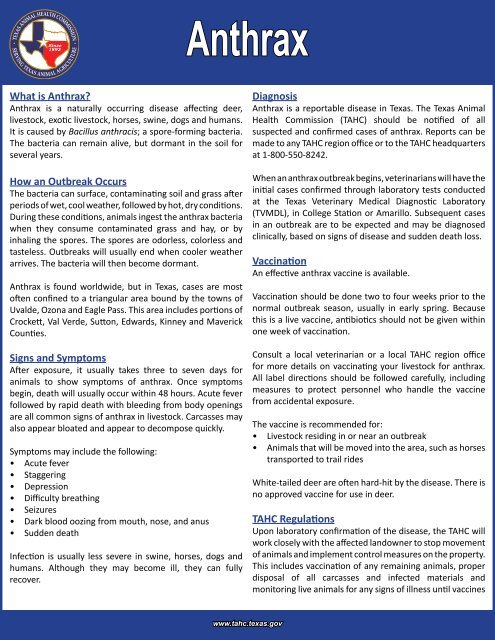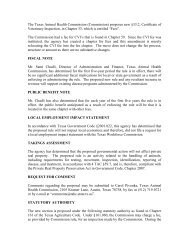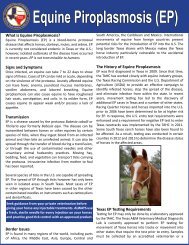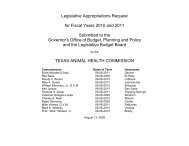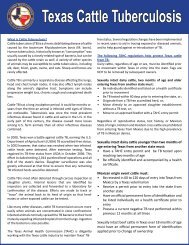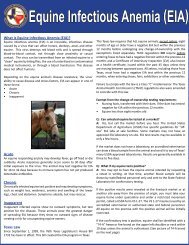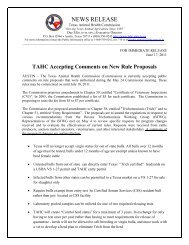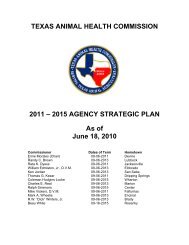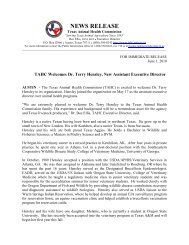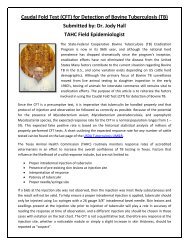TAHC Anthrax Brochure - Texas Animal Health Commission
TAHC Anthrax Brochure - Texas Animal Health Commission
TAHC Anthrax Brochure - Texas Animal Health Commission
- No tags were found...
You also want an ePaper? Increase the reach of your titles
YUMPU automatically turns print PDFs into web optimized ePapers that Google loves.
TEXAS ANIMAL HEALTH COMMISSION• •<strong>Anthrax</strong>Since1893SERVING TEXAS ANIMAL AGRICULTUREWhat is <strong>Anthrax</strong>?<strong>Anthrax</strong> is a naturally occurring disease affecting deer,livestock, exotic livestock, horses, swine, dogs and humans.It is caused by Bacillus anthracis; a spore-forming bacteria.The bacteria can remain alive, but dormant in the soil forseveral years.How an Outbreak OccursThe bacteria can surface, contaminating soil and grass afterperiods of wet, cool weather, followed by hot, dry conditions.During these conditions, animals ingest the anthrax bacteriawhen they consume contaminated grass and hay, or byinhaling the spores. The spores are odorless, colorless andtasteless. Outbreaks will usually end when cooler weatherarrives. The bacteria will then become dormant.<strong>Anthrax</strong> is found worldwide, but in <strong>Texas</strong>, cases are mostoften confined to a triangular area bound by the towns ofUvalde, Ozona and Eagle Pass. This area includes portions ofCrockett, Val Verde, Sutton, Edwards, Kinney and MaverickCounties.Signs and SymptomsAfter exposure, it usually takes three to seven days foranimals to show symptoms of anthrax. Once symptomsbegin, death will usually occur within 48 hours. Acute feverfollowed by rapid death with bleeding from body openingsare all common signs of anthrax in livestock. Carcasses mayalso appear bloated and appear to decompose quickly.Symptoms may include the following:• Acute fever• Staggering• Depression• Difficulty breathing• Seizures• Dark blood oozing from mouth, nose, and anus• Sudden deathInfection is usually less severe in swine, horses, dogs andhumans. Although they may become ill, they can fullyrecover.Diagnosis<strong>Anthrax</strong> is a reportable disease in <strong>Texas</strong>. The <strong>Texas</strong> <strong>Animal</strong><strong>Health</strong> <strong>Commission</strong> (<strong>TAHC</strong>) should be notified of allsuspected and confirmed cases of anthrax. Reports can bemade to any <strong>TAHC</strong> region office or to the <strong>TAHC</strong> headquartersat 1-800-550-8242.When an anthrax outbreak begins, veterinarians will have theinitial cases confirmed through laboratory tests conductedat the <strong>Texas</strong> Veterinary Medical Diagnostic Laboratory(TVMDL), in College Station or Amarillo. Subsequent casesin an outbreak are to be expected and may be diagnosedclinically, based on signs of disease and sudden death loss.VaccinationAn effective anthrax vaccine is available.Vaccination should be done two to four weeks prior to thenormal outbreak season, usually in early spring. Becausethis is a live vaccine, antibiotics should not be given withinone week of vaccination.Consult a local veterinarian or a local <strong>TAHC</strong> region officefor more details on vaccinating your livestock for anthrax.All label directions should be followed carefully, includingmeasures to protect personnel who handle the vaccinefrom accidental exposure.The vaccine is recommended for:• Livestock residing in or near an outbreak• <strong>Animal</strong>s that will be moved into the area, such as horsestransported to trail ridesWhite-tailed deer are often hard-hit by the disease. There isno approved vaccine for use in deer.<strong>TAHC</strong> RegulationsUpon laboratory confirmation of the disease, the <strong>TAHC</strong> willwork closely with the affected landowner to stop movementof animals and implement control measures on the property.This includes vaccination of any remaining animals, properdisposal of all carcasses and infected materials andmonitoring live animals for any signs of illness until vaccineswww.tahc.texas.gov
TEXAS ANIMAL HEALTH COMMISSIONhave time to take effect. <strong>Animal</strong>s will be allowed to moveoff the property again only when it is deemed safe to do so.Carcass Disposal and Disinfection<strong>TAHC</strong> regulations require that the owners and/or caretakersburn each carcass until they are thoroughly consumed toprevent further contamination of the soil with the organism.Burning carcasses is the only method to ensure that theanthrax bacteria will be killed.Due to environmental concerns, heavy oils or tires to burncarcasses should not be used! Fuels permitted by the <strong>Texas</strong><strong>Commission</strong> on Environmental Quality (TCEQ) includegasoline, diesel or wood.Care should be taken to keep fires from burning out ofcontrol. In counties under a burn ban, burning MUST becoordinated with local fire authorities prior to carcassdisposal.If the animal was housed in a barn, the carcass, bedding,manure, other contaminated material and surrounding soilshould be promptly removed and burned. Consult yourveterinarian for appropriate methods to decontaminatethe soil. To disinfect panels, trailers, milking facilities orequipment, use an ammonia-based disinfectant, peroxides,or chlorine dioxide labeled as effective for anthrax. All labeldirections should be carefully followed.Safety PrecautionsWhen dealing with vaccines and/or carcasses practice goodbiosecurity:• Wear long sleeves and gloves• Do not move or open bloated carcasses as that couldrelease bacteria into the air• Do not salvage hides, horns, antlers, skulls or any othertissue from the carcassesHands should be washed thoroughly! Consult your physicianfor treatment if you suffer a needle stick, splash vaccinein cuts or scratches, or if you develop a sore or lesionsafter handling vaccine, livestock or carcasses. Humansmay contract a skin form of anthrax that requires specificantibiotic treatment.Dogs should be kept out of pastures and away from carcassesduring an anthrax outbreak. They may develop an infectionfrom the bacteria and may require treatment.Swimming in stock tanks or stagnant ponds where deathlosses have occurred is not safe and should not be done.Streams, however, are considered safer, as the movingwater will dilute organisms. <strong>Animal</strong> carcasses located instreams or rivers should be promptly reported to the localsheriff or police departments.During an outbreak, wild hogs shot in an affected areashould not be consumed. Swine may have fed on carcassesand although swine are resistant to anthrax, they maytemporarily harbor the bacteria.Advice for Hunters• Wear latex gloves when processing game, to preventpotential exposure to bacteria, viruses or parasites• Thoroughly cooked meat is considered safe to eat• •Since1893SERVING TEXAS ANIMAL AGRICULTUREInformation provided by the<strong>Texas</strong> <strong>Animal</strong> <strong>Health</strong> <strong>Commission</strong>P.O. Box 12966 - Austin, TX 78711-2966www.tahc.texas.govFebruary 2015


